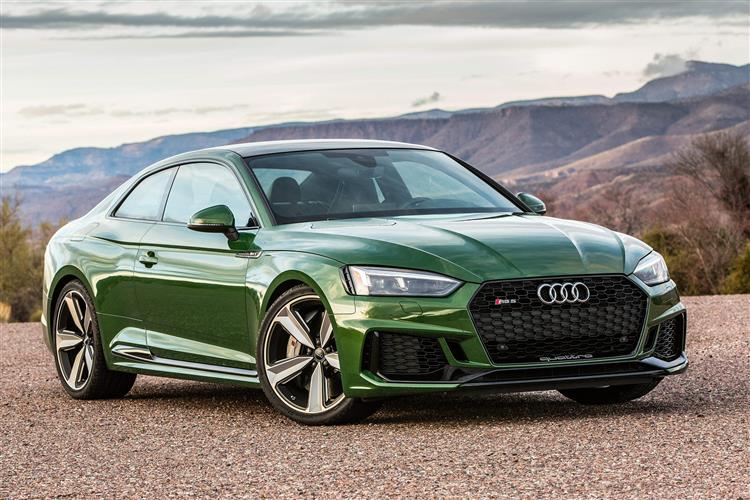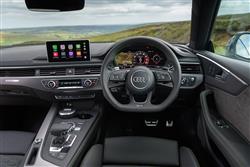THE FAST SHOW (some text hidden) --NONE--
By Jonathan Crouch
Introductionword count: 86
Back in 2017, the second generation version of Audi's RS 5 moved from V8 to biturbo V6 power as part of a significantly more sophisticated package that edged this Ingolstadt contender closer to the standards being set by top BMW and Mercedes rivals. The key RS 5 advantage remained in its provision of 4WD, but there were also plenty of other reasons for customers to choose one over an M4 or a C63 from this period. Let's check this B9-era design out as a used buy.
Modelsword count: 7
3dr Coupe / 5-Door Hatch (2.9 TFSI)
Historyword count: 431
Can a more efficient high performance sportscar also be a more rewarding one? Audi says it can and in 2017 confirmed its intention to deliver just that with this model, the fearsomely fast second generation RS 5, launched in 2017 as a Coupe and in 2019 also in five-door Sportback form. Unlike with the previous generation RS 5, there was no Cabriolet version. The word 'efficient' always has to be used with a degree of relativity when you're talking of a contender that fronts up with as much as 450PS, but it's certainly applicable here. This MK2 model claimed to be up to 25% more efficient than its predecessor, yet was every bit as quick. The credit for that lay with the two fundamental changes made to this B9-era design; the introduction of an all-new stiffer, lighter MLB platform. And the replacement of the previous version's 4.2-litre V8 with a cutting-edge 2.9-litre twin-turbo V6. That last change was the one that made the headlines when this car was launched in the Summer of 2017. After all, that old V8 was in many ways the engine that really established Audi RS products as top flight performance contenders. Back in 2005, this was the powerplant used to launch the glorious R8 sportscar and the one that at last put Ingolstadt's RS 4 model on an equal footing with its BMW M3 arch-rival. Whether it was also the right unit to power the first generation version of this car, launched back in 2011, was more debateable. That old RS 5 Coupe was already much heavier than direct rivals from BMW and Mercedes and plugging in such an enormous engine up-front hobbled it further when it came to trying to provide the kind of engaging driving dynamics that buyers in the high performance coupe segment crave. So the engineers at Audi Sport started again, working with Porsche to create a lighter, more responsive 2.9-litre twin turbo V6 able to equal the total output of the previous model and vastly improve upon its pulling power. They then mated that engine not only to those more agile underpinnings but also to a more responsive 8-speed Tiptronic paddleshift auto gearbox. In addition, Audi's traditional advantage over direct rivals like the Mercedes-AMG C63 Coupe and the BMW M4 - its quattro 4WD system - was here retained and improved. And there was a standard rear Sport differential to further help get the torque to the tarmac through the turns. There was a mid-term update for both Coupe and Sportback RS 5 models in 2020; and production finished in 2024.
What You Getword count: 413
There were two B9-era RS 5 models, the Coupe version most chose or an alternative five-door Sportback model. The RS-branded A5 Coupe wasn't quite as stylistically subtle as its lesser S5 stablemate - nor would you want it to be. Appropriately, aesthetic inspiration came from a competition model, Audi's 90 quattro IMSA GTO racer, hence the blistered wheelarches, the lacerated air intakes and the huge oval exhaust pipes. It's certainly a slightly larger car than its predecessor - thank the new MLB Evo platform for a 74mm increase in length - and the more purposeful stance is a touch lower too. As for the elements that set this RS 5 model apart at the wheel, well of course, the flat-bottomed RS sport leather steering wheel with red contrast stitching is bespoke. So are the stainless steel pedals and the lovely nappa leather-trimmed honeycomb-stitched winged RS Super Sport seats. Otherwise, apart from the leather-fashioned door armrests and kneepads and the black cloth headlining, the ambience is exactly as it would be in any plushly-specified A5 model. You'll really like the seats, anatomically-shaped and perfectly positioned in front of a wheel through which you view the all-digital Audi 'Virtual Cockpit'. You may be familiar with this set-up from some of the brand's other models from this era. Here, it was standard, a 12.3-inch LCD colour monitor that replaces the usual instrument binnacle dials with a layout that's fully digital and customisable, using smart 3D graphics and highly detailed effects. Anything the 'Virtual Cockpit' set-up can't tell you will almost certainly be covered by the slimline MMI infotainment display that dominates the top of the dashboard. Appropriately, this flagship model includes Audi's top 'MMI Navigation Plus with MMI touch' package with its 8.3-inch monitor featuring crisp 3D maps and responsive Nvidia graphics. This display was upgraded in size to 10.1-inches as part of the 2020 model update. As for the rear, well buyers in search of a two-door design tend to transport adults in the back very infrequently but when the need does arise, this RS 5 Coupe can improve a little on the claustrophobic quarters provided by some of its closest rivals. Finally, let's consider the boot. This trunk area gained 10-litres in size with this second generation model's longer design and at launch was the largest in the segment at 465-litres. The RS 5 Sportback, in contrast, offers a 480-litre boot, extendable to 1,300-litres in size if you push forward the rear seat back.
To see the full road test text contact us on 0330 0020 227
Pictures (high res disabled)

.jpg)
|
.jpg)
|
.jpg)
| |||
.jpg)
|
.jpg)
|
.jpg)
| |||
.jpg)
|

|
Scoring (subset of scores)
Category: Sporting Cars
| Performance | |
| Handling | |
| Comfort | |
| Space | |
| Styling, Build, Value, Equipment, Depreciation, Handling, Insurance and Total scores are available with our full data feed. | |



